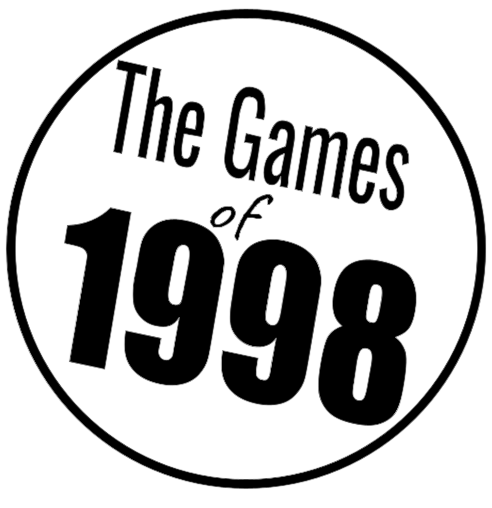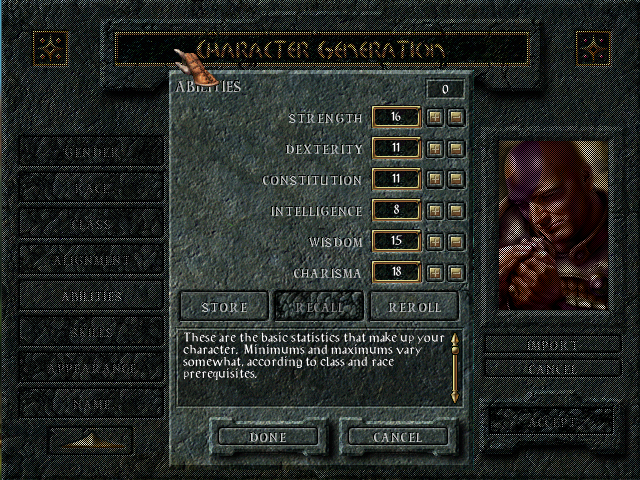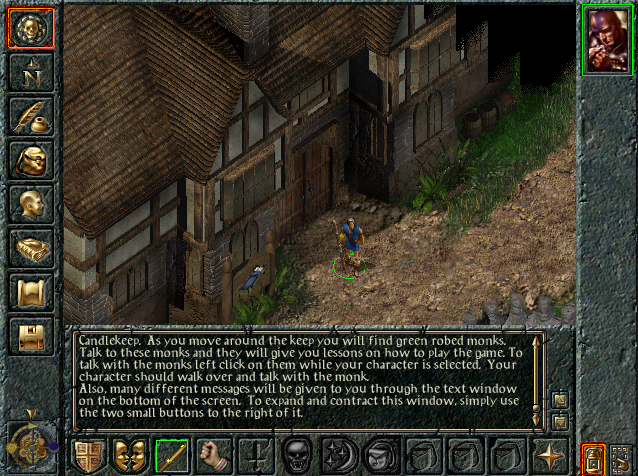Baldur’s Gate
Release Date - December 21, 1998 (NA)
Developer - Bioware, Black Isle Studios
Publisher - Interplay Entertainment
Platform - PC
Everyone loves an underdog. Everyone loves hearing the story about the longshot that managed to overcome the odds and become a hero. Perhaps mirroring the game’s own story of coming from a humble beginning to achieve great things, Baldur’s Gate was a game that defied the expectations.
Baldur’s Gate was only the second game made by the then-new developer Bioware (their first being the moderately successful Shattered Steel in 1996). The founders and staff at Bioware were keen pen and paper role playing game (RPG) aficionados and were therefore interested in making a video game that could capture that gameplay and feeling. This decision alone made the game something of an underdog, with the genre of computer RPGs (CRPG) becoming stale over the last few years. Various attempts had been made to capture the magic of pen and paper RPGs for a computer game, but most had fallen short of expectations.
A tranquil walk through the woods can be interrupted at any time…
When the game was nearing completion, internal estimates for sales topped out between a conservative 50,000 units and an optimistic 200,000 units. With these sales figures in mind, the publisher only shipped 50,000 units to retailers for the initial print run. Baldur’s Gate would release in December 1998 and almost immediately sold out. By November 1999, the game had already sold over one million units.
The first thing you’ll see when starting a game of Baldur’s Gate is the character creation screen. Gamers were impressed by the amount of choices made available to them, and of their importance, when it came to creating your character. Building your character is a huge part of Dungeons and Dragons, and Baldur’s Gate captures that essence with a brilliantly detailed and open character creator. Players can choose their character's race, class and moral alignment among other aspects, and the decisions made at the creation screen will affect how you interact with other characters in the world and the path you’ll take through your journey.
Character creation can get more involved than most games.
You’ll also need to ‘roll’ for your character’s abilities; literally rolling the dice to see what their statistics will be. This will determine things such as Strength, Intelligence, Dexterity, Charisma and the like. The random element is in line with the original pen and paper RPG rules, and while you can re-roll as many times as you like, you’ll probably not get exactly what you want. It goes a long way to preventing players just following a ‘build guide’ to the letter, and means that you’ll get characters with flaws and quirks. Abilities will affect how you play the game a great deal, as they determine how much damage you can take or dish out, spells that you can or cannot use and even dialogue options. There are different races you can play as, different classes you can train in, and different alignments to good or evil you can choose. Some of these are mutually exclusive (for example, you cannot be a Paladin without being Lawful Good), so you might spend quite a bit of time fine-tuning what you want. You might also just beeline straight to a more simple character, which is also a very valid way to play the game. Basically, you can go as deep or as shallow as you like, and experts will have a great time crafting unique characters for subsequent playthroughs.
Make sure to keep on the good side of the various temples around the Sword Coast, you’ll need them to revive fallen teammates!
Your character begins the game having to leave the monastery he has spent his whole life in. Leaving under desperate circumstances, a flight for survival means finding friends that can assist you. The game very quickly teaches you that trust must be placed very carefully, with a conspiracy soon being discovered. The story progresses at a great pace, with many twists and turns and slow reveals of increasingly elaborate plans from shadowy characters. Ah, and what great characters there are to meet… Just like in real-life, not everyone you meet is going to be your friend. Encounters with NPCs are far more than just ‘quest vending machines’, with many characters attempting to gain your trust only to betray you, or otherwise displaying some deceptive techniques. It’s very refreshing to play a game that triggers your instincts that something isn’t quite right, and being rewarded for it.
Exploring new areas is always exciting. Sometimes terrifying.
Beyond just having a great character creation kit for your protagonist, Baldur’s Gate is also beloved for the quality of companions that make up your party. Contemporary reviews praised the companions as being some of the best written and most intriguing in a CRPG ever, to this day they are examples of excellently written characters that add to the story.
Companions range from childhood friends that are handy with a bow and lockpick, to a husband and wife duo that are handy with swords and cleric spells and even an odd-couple (and seemingly evil) necromancer human and fighter-dwarf. Perhaps most famous is Minsc; the fearsome warrior who’s taken a few too many hits to the head over the years, and now believes that his beloved pet Boo is actually a Space Hamster.
CGI cutscenes are used sparingly, but you get some nice establishing movies when visiting major new locations!
Companions form an interesting dynamic throughout the adventure, as you can only have 5 companions at any given time in your party. Every character has their own allegiances and goals, and may not get along with others you have or wish to recruit. Evil characters don’t get along well with characters aligned with Good, and many will also join your party on the condition that you assist them with a quest. Many of these are timed, and characters will abandon you if they think you’re taking too long to help out. The characters will even talk amongst themselves on your journeys, complimenting or throwing barbs at each-other depending on their relationships. Each companion has a unique voice, usually with distinctive accents or mannerisms. It goes a long way to simulating the feeling that you’re playing in and with a living world.
The story and dialogue is complemented well by an atmospheric soundtrack that draws you deep into the world of the Forgotten Realms. Music suits the situation, and while you may have some delightfully relaxing instrumental music playing when exploring an idyllic countryside or quiet town, you’ll also have some far more sinister and intense battle music when fighting opponents. Likewise, heading to an inn will be accompanied by the sounds of patrons laughing and chatting and some festive music that’s all but drowned out by the chatter. In a nice touch, NPCs will give snippets of voice acting as you walk through populated areas.
You’ll start out all on your own, but soon be joined by a very varied cast of potential companions.
Baldur’s Gate is far from the best-looking game to release in 1998, especially when compared to some of the cutting edge games released in the same year. The lack of sheer technical graphical output is countered by a beautiful art direction. Beautifully drawn and detailed backdrops make up the various locations of the Sword Coast where the game is set, with some excellent character portraits to give the tiny figures some extra personality. At any time, you can check your world map to see all the locations you know of. The map looks sparse initially, but quickly gets filled in as you find more and more locations in the densely detailed region. (To give an idea of just how much there is to see, in my first playthrough it took me about 30 hours just to get to Baldur’s Gate. Pretty impressive that there was that much content available, before even getting to the location the game is named after!)
This map hasn’t been completed yet, there’s even more locations to discover. This doesn’t even display the metropolis that is Baldur’s Gate!
The combat is in real time, with a ‘pause to give commands’ style of play. While things happen in real-time, the combat still replicates the ‘turn based’ nature of Dungeons and Dragons with the turns and dice rolling happening behind the scenes. It all works quite well to keep the game moving at a good pace, while still ensuring that all the interactions are driven by dice rolls and statistics. The game rewarded players for treading cautiously and heeding warnings from conversations or reading the in-game clues, as wandering into a dangerous area meant you and your party could be wiped out very quickly. It pays to soak in the rich atmosphere and peripheral information in the Forgotten Realms… You’ll quickly learn that thieves with ‘detect traps’ ability are worth their weight in gold after you accidentally open a booby-trapped foot locker. Likewise, you’ll come to learn to not use magic or enchanted clothing unless you know exactly what they are. Having some companions who are well-versed in such things will allow you to identify potentially dangerous items and potions before you accidentally drink something you really shouldn’t.
This is game that rewards careful play. Don’t just assume the best for unknown items, or you might accidentally have memorised this ‘Cursed Scroll of Stupidity’.
The game can be quite punishing, especially if you’re not familiar with RPGs in general. Characters getting killed in battle means having to haul all their equipment back to a temple, lest you lose it by leaving it behind. Depending on how much you have to carry, you might have to make some tough decisions about what loot to leave behind. That’s not even mentioning the fact that characters cannot be raised from the dead if they’ve been blown to bits by a particularly nasty spell or powerful brute… Exploring the game is very rewarding, with many inconspicuous characters offering bits of information and even quests to fulfil. Going through people’s personal belongings is a risky business, as many don’t appreciate you looting their homes and will call guards on you. This also affects your party’s Good/Evil alignment, which has knock-on affects on companions and whether they’ll stick with you or not! Characters can only memorise so many spells, and must copy them over to their spell-books. Characters get tired and must rest. Sleeping out in the open can mean that you’re ambushed in the night by bandits (or worse). There’s just so many brilliant mechanics at play, the game is punishing but very rewarding when you learn just how much is going on. Once again, it really feels like you’re in a living, breathing world, one that is much more authentic feeling than most games of today.
Locations really feel unique and alive. This is a stone keep that’s been converted into an inn, and one of the first safe-havens you’ll come across.
It would be remiss not to mention the fantastic manuals that come with the game. Not one, but two ‘manuals’ were included. The first giving the usual instructions on setup and gameplay and controls and the like, and the second being a wonderful piece of fiction in the form of a traveller’s guide to Baldur’s Gate. This second manual gives a huge amount of information on the history of the continent and the city of Baldur’s Gate, as well as surprisingly in-depth and well-written guides to the major locations and establishments you’ll find in the game! Accompanying this was a beautifully illustrated map of the game area. This kind of material wasn’t uncommon at the time, but it really adds a great deal to the immersion and enjoyment of the game.
Lots of spells to learn, but knowing which are the most important to you is the key.
The game would receive glowing reviews on release, with PC Gamer writing that Baldur's Gate "reigns supreme over every RPG currently available, and sets new standards for those to come". The game also won a number of “RPG of the Year” awards, as the press and gamers alike heaped praise onto the game. Following the game’s success, an expansion pack Tales of the Sword Coast was released in 1999, and a sequel was released in 2000. Perhaps even more important was the lineage that followed; Baldur’s Gate laid the groundwork for more legendary CRPGs that would follow the standards and rules that were established, games like Planescape: Torment and Icewind Dale. With a legacy like that, it’s no wonder this game has earned its place in history as a legendary role-playing game.
Dripping with atmosphere and personality, this is a game that even the most seasoned RPG veteran will love.












